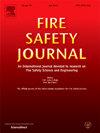Influences of typical forest vegetation combustion processes on breakdown characteristics and mechanisms of wire-wire air gaps
IF 3.3
3区 工程技术
Q2 ENGINEERING, CIVIL
引用次数: 0
Abstract
Worldwide, high voltage transmission lines have been suffering from frequent tripping accidents caused by wildfires. To further investigates the impacts of wildfire on breakdown characteristics and mechanisms of wire-wire air gaps, three typical forest vegetation samples were used as simulated fire sources in this work. Two segments of aluminum conductors steel reinforced (ACSR) were used as electrodes. The main flame characteristics, mass loss rate (MLR), and heat release rate (HRR) of the vegetation, main discharge breakdown characteristics of the wire-wire gap distances (5.0–25.0 cm) with fire, and the arc evolution processes under flame conditions were measured and analyzed. Results show that fir has the highest combustion intensity. In both flame zones, the wire-wire air gaps of fir are all the most prone to discharge breakdowns, except for a 5 cm gap in oscillating flame zone. Eucalyptus always shows a medium difficulty. The mean breakdown field strengths of eucalyptus, thatch and fir in continuous and oscillating flame zones decrease sequentially by 78.02 %–84.67 % and 46.51 %–53.67 % respectively compared to that in pure air. Mechanism analyses indicate that high temperatures, ionized particles, thermal convection, radiation, flame zones and electric field interactions are the primary driving forces, reducing gap insulation, and ultimately leading to breakdown.
典型森林植被燃烧过程对钢丝气隙击穿特性及机理的影响
在世界范围内,因火灾引起的高压输电线路跳闸事故屡见不鲜。为了进一步研究野火对金属丝气隙击穿特性的影响及其机理,本研究以三种典型森林植被样本作为模拟火源。采用两段钢增强铝导体(ACSR)作为电极。测量并分析了植被的主要火焰特性、质量损失率(MLR)、放热率(HRR)、着火时钢丝间隙距离(5.0 ~ 25.0 cm)的主要放电击穿特性以及火焰条件下的电弧演化过程。结果表明,杉木的燃烧强度最高。在两个火焰区,除了振荡火焰区有5cm间隙外,杉木的导线气隙最容易发生放电击穿。桉树总是显示中等难度。连续和振荡火焰区桉树、茅草和冷杉的平均击穿场强比纯空气中依次下降78.02% ~ 84.67%和46.51% ~ 53.67%。机理分析表明,高温、电离粒子、热对流、辐射、火焰区和电场相互作用是导致间隙绝缘减小的主要驱动力,最终导致击穿。
本文章由计算机程序翻译,如有差异,请以英文原文为准。
求助全文
约1分钟内获得全文
求助全文
来源期刊

Fire Safety Journal
工程技术-材料科学:综合
CiteScore
5.70
自引率
9.70%
发文量
153
审稿时长
60 days
期刊介绍:
Fire Safety Journal is the leading publication dealing with all aspects of fire safety engineering. Its scope is purposefully wide, as it is deemed important to encourage papers from all sources within this multidisciplinary subject, thus providing a forum for its further development as a distinct engineering discipline. This is an essential step towards gaining a status equal to that enjoyed by the other engineering disciplines.
 求助内容:
求助内容: 应助结果提醒方式:
应助结果提醒方式:


